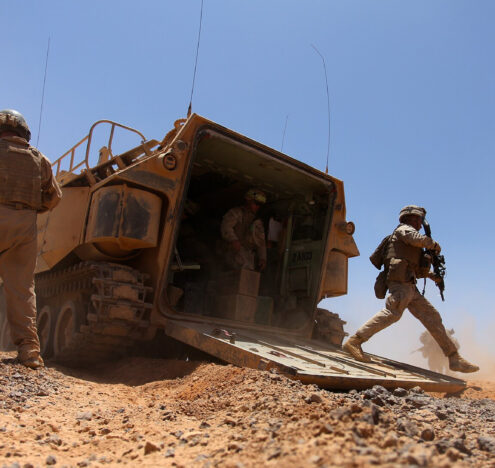This analysis was featured in Critical State, a weekly newsletter from Inkstick Media and The World. Subscribe here.
When a thermonuclear bomb detonates, it creates a fission and then a fusion reaction, shearing energy from atoms at such intensity that it burns hotter than the surface of the sun. The effects are known, tested, simulated, and studied, with a ring pattern around every blast that shows the intensity of radiation. The simulation shows the fireball, blast, and thermal radiation from the lowest yield warhead to the most powerful, with the difference being not the kind of harm done but the scale of who gets caught in that harm. Yet, this blunt truth — that any nuclear weapon is still a nuclear weapon — can get lost in the war planning and theorizing by militaries and political leaders.
The word “tactical,” sometimes thrown around to encompass weapons with a yield multiple times that of the bombs dropped on Hiroshima and Nagasaki, obscures the conversation, and misses the fundamental strategic choice inherent in any use of any nuclear weapon.
While the United States may perceive its introduction of a lower-yield submarine warhead as a way to manage risk, it has likely not been received as such.
In “Deterring Russian Nuclear Threats with Low-Yield Nukes May Encourage Limited Nuclear War,” Jeffrey Taylor looks at moves by the United States to develop a low-yield warhead for use by submarine-launched missiles. Taylor’s piece, published shortly after Russia’s February 2022 invasion of Ukraine, doesn’t address that specific conflict. Instead, it offers a window into what was knowable about Russian policy on low-yield nukes, captured in the moments leading up to Moscow’s disastrous war of choice.
“Russia is estimated to have more than 2,000 nonstrategic nuclear warheads, many of which are thought to be stationed in western Russia within range of critical NATO targets,” writes Taylor. “The United States has only around 200 low-yield nuclear weapons in Europe. The majority of these are gravity bombs that must be carried to their targets by air platforms that are susceptible to Russia’s sophisticated air defense systems. From a purely capability-based standpoint, this appears to leave the United States without a credible proportionate response option to a Russian low-yield nuclear threat.” Taylor also explains that US officials worry that Russia may seek to leverage this asymmetry in capability to gain a nuclear advantage — a worry that continues to exist as Russia’s war on Ukraine continues.
The submarine-launched low-yield warhead isn’t subject to the same rules around use and basing as gravity bombs stored on bases in NATO countries, thus freeing it to some degree from NATO’s consensus-based warmaking powers. This weapon already exists; it marked its first deployment in late 2019, at most a few 5-kiloton warheads amidst the submarine’s normal complement of 90-kiloton and 455-kiloton warheads.
While the United States may perceive its introduction of a lower-yield submarine warhead as a way to manage risk, it has likely not been received as such.
Ultimately, notes Taylor, “some analysts argue that new US nuclear policies involving low-yield nuclear weapons may actually stabilize Russian strategies for limited nuclear use by presenting a credible response option to a Russian limited strike short of high-yield nuclear weapons, thereby reducing the risk of high-level nuclear escalation. Therefore, in scenarios most likely to elicit Russian nuclear use, deterrence using low-yield nuclear weapons is unlikely to prevent, and may encourage, limited nuclear conflict.”




















